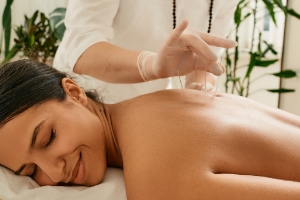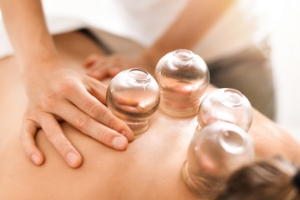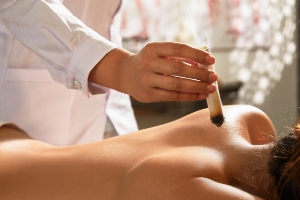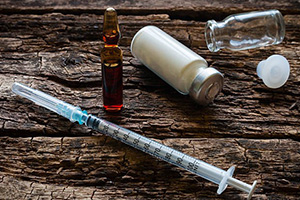No products in the cart.
Flex (SPR)
CLINICAL APPLICATIONS
- Bone spurs with pain and inflammation
- Joint stiffness
- Calcification of joints
- Plantar fasciitis
- Spine pain
WESTERN THERAPEUTIC ACTIONS
- Analgesic action to relieve pain associated with bone spurs
- Anti-inflammatory influence to reduce inflammation
INGREDIENTS
- Bai Zhi (Radix Angelicae Dahuricae)
- Chen Pi (Pericarpium Citri Reticulatae)
- Da Ding Huang (Caulis Euonymi)
- Dang Gui (Radix Angelicae Sinensis)
- Fang Feng (Radix Saposhnikoviae)
- Gan Cao (Radix et Rhizoma Glycyrrhizae)
- Huang Jin Gui (Caulis Vanieriae)
- Jin Yin Hua (Flos Lonicerae Japonicae)
- Liu Zhi Huang (Herba Solidaginis)
- Mo Gu Xiao (Caulis Hyptis Capitatae)
- Mo Yao (Myrrha)
- Po Bu Zi Ye (Folium Cordia Dichotoma)
- Ru Xiang (Gummi Olibanum)
- Tong Cao (Medulla Tetrapanacis)
- Zao Jiao (Fructus Gleditsiae)
- Zao Jiao Ci (Spina Gleditsiae)
- Zhe Bei Mu (Bulbus Fritillariae Thunbergii)
FORMULA EXPLANATION
Flex (SPR) is formulated to relieve pain from bone spurs and joint stiffness arising from overuse. According to theories in traditional Chinese medicine, bone spurs form as the result of repetitive use and are diagnosed as stagnation of blood and phlegm.
Po Bu Zi Ye (Folium Cordia Dichotoma) regulates qi circulation and relieves pain. Unbeknownst to most practitioners, it is one of the most effective herbs in the Chinese Materia Medica to treat bone spurs. Mo Gu Xiao (Caulis Hyptis Capitatae), Liu Zhi Huang (Herba Solidaginis), and Huang Jin Gui (Caulis Vanieriae) have anti-inflammatory and analgesic effects and are often used to treat acute pain associated with traumatic injuries or sprains and strains. Da Ding Huang (Caulis Euonymi) further reduces inflammation and relieves pain. Ru Xiang (Gummi Olibanum), Mo Yao (Myrrha), and Dang Gui (Radix Angelicae Sinensis) have potent effects on moving blood, dispersing blood stagnation, and relieving pain. Jin Yin Hua (Flos Lonicerae Japonicae), Bai Zhi (Radix Angelicae Dahuricae), Zhe Bei Mu (Bulbus Fritillaria Thunbergii), Zao Jiao (Fructus Gleditsiae), and Zao Jiao Ci (Spina Gleditsiae) break up phlegm that is obstructing the channels and joints to restore proper qi and blood circulation. Chen Pi (Pericarpium Citri Reticulatae) regulates qi, while Fang Feng (Radix Saposhnikoviae) disperses wind and releases pain lodged in peripheral levels of the body. Tong Cao (Medulla Tetrapanacis) drains the accumulation of dampness and phlegm from the body via urination. Lastly, Gan Cao (Radix et Rhizoma Glycyrrhizae) relieves pain and harmonizes the formula.
In summary, Flex (SPR) is an effective formula with immediate and long-term therapeutic benefits.
Po Bu Zi Ye (Folium Cordia Dichotoma) regulates qi circulation and relieves pain. Unbeknownst to most practitioners, it is one of the most effective herbs in the Chinese Materia Medica to treat bone spurs. Mo Gu Xiao (Caulis Hyptis Capitatae), Liu Zhi Huang (Herba Solidaginis), and Huang Jin Gui (Caulis Vanieriae) have anti-inflammatory and analgesic effects and are often used to treat acute pain associated with traumatic injuries or sprains and strains. Da Ding Huang (Caulis Euonymi) further reduces inflammation and relieves pain. Ru Xiang (Gummi Olibanum), Mo Yao (Myrrha), and Dang Gui (Radix Angelicae Sinensis) have potent effects on moving blood, dispersing blood stagnation, and relieving pain. Jin Yin Hua (Flos Lonicerae Japonicae), Bai Zhi (Radix Angelicae Dahuricae), Zhe Bei Mu (Bulbus Fritillaria Thunbergii), Zao Jiao (Fructus Gleditsiae), and Zao Jiao Ci (Spina Gleditsiae) break up phlegm that is obstructing the channels and joints to restore proper qi and blood circulation. Chen Pi (Pericarpium Citri Reticulatae) regulates qi, while Fang Feng (Radix Saposhnikoviae) disperses wind and releases pain lodged in peripheral levels of the body. Tong Cao (Medulla Tetrapanacis) drains the accumulation of dampness and phlegm from the body via urination. Lastly, Gan Cao (Radix et Rhizoma Glycyrrhizae) relieves pain and harmonizes the formula.
In summary, Flex (SPR) is an effective formula with immediate and long-term therapeutic benefits.
BACKGROUND
Bone spurs form in response to pressure, rubbing, or stress on the same joint over a long period. As the body tries to protect and repair itself, it builds extra bone on top of normal bone. Most bone spurs are smooth and do not cause pain. However, some bone spurs may press or rub on other bones or soft tissues, causing pain, inflammation, and burning sensations.






